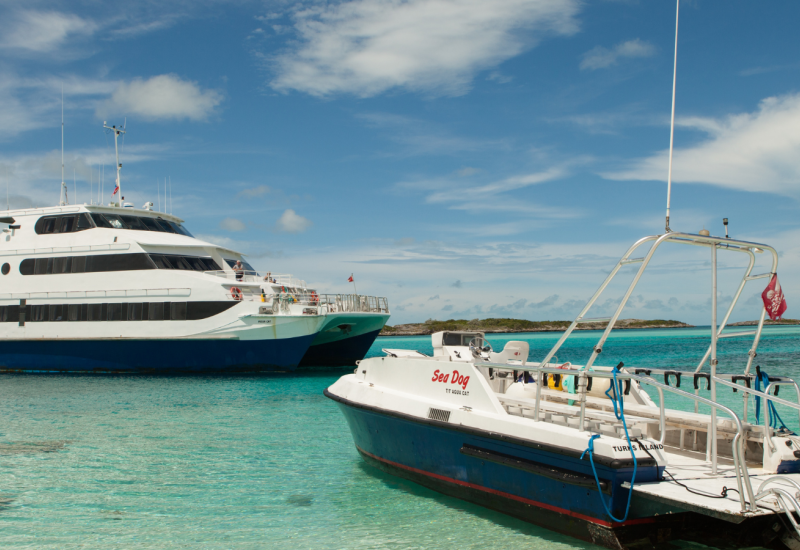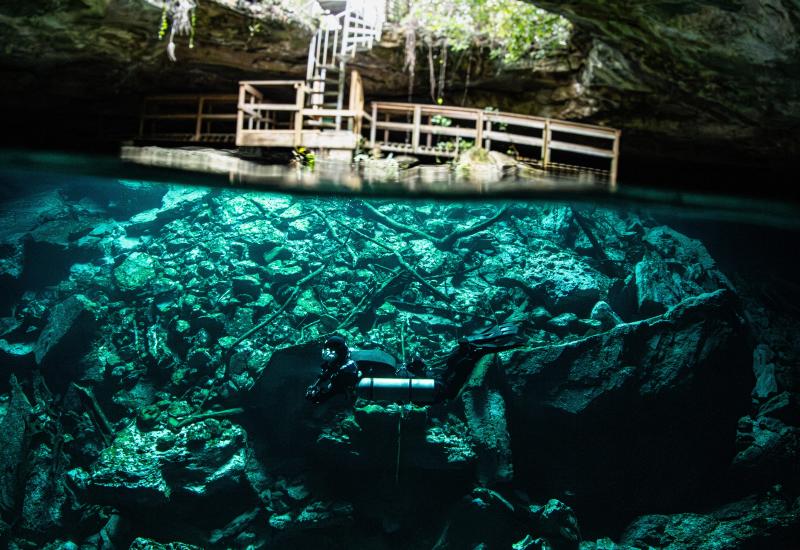A Week of Thrills Aboard The Sea Explorer in The Bahamas

Brandi MuellerA blenny rests on coral.
Every diver on the boat was fully geared up. We sat in our BCDs with all air removed, ready to make a negative entry, fins on, and masks defogged awaiting our cue to get in the water. The Sea Explorer, part of All Star Liveaboard’s Blackbeard’s Cruises, was lining us up for a perfect drop into the world-famous Washing Machine dive. When the captain counted down from ten…nine…eight and finally calling out “dive, dive, dive,” we stood up and with the boat still moving jumped one-by-one into a drift diving adventure.
Splashing in one after another we descended immediately, already feeling a bit discombobulated as we twisted and turned to get comfortable in the water while looking around for our dive guides and buddies. It seemed like a miracle, but everyone was right where they were supposed to be. Our dive guide, Thato, was in the lead and she turned around to check that we were all okay with hand signals. Dive guide Steven was in the back, acting as our shepherd. The rest of the divers were somewhere in the middle and already flying like Superman over a seemingly endless seagrass bed.
Prior to jumping in, our dive briefing included step-by-step instructions, including tips for really experiencing the spin (hug your knees into a ball) or if you wanted less spin (spread your legs and arms out to make yourself bigger.) It was also possible to avoid the spinny-part by veering a little bit to the right when arriving at the underwater ledge where the depth dropped off. A few divers stayed with the Shepard (dive guide Steven) and he showed them where to go for no spin.
The current was strong, but it didn’t matter because we weren’t fighting it at all. The boat would be on the other side waiting to pick us up wherever the current took us. Still flying, we were headed straight for the Washing Machine — which occurs due to a unique underwater landscape in between two islets formed by a sudden drop in depth at a wall-like canyon area, which makes the water move in a circle. We could see the ledge in front of us and Thato give us a hand signal with her finger spinning in a circle. We were almost there.
I saw several divers in front of me disappear over and down the ledge and then reappear moving upward and circling around, they were in the spin cycle. Pretty soon I too was moving straight down, then I was drifting back upward in a circle, the neatest thing was that I was moving faster than my bubbles. The bubbles I had previously exhaled were soon below me until the spin took me back down again where I burst out laughing, bubbles everywhere.

Brandi MuellerAirplane wreck in the Bahamas.
After two spins I was spat out on the other side, current still racing, but the seafloor was flat again with seagrass and reef. Continuing to fly like underwater superheroes (and clean ones, at that) we drifted until our dive computers said 40 minutes, then decided it was time to go up for a safety stop and end the dive. The Sea Explorer was there to pick us up when we surfaced.
After our trip through the spin cycle, the day’s excitement was not over. The captain moved the boat to a wreck dive called the Austin Smith and we heard rumors there might be sharks. Another in-depth dive briefing was given and we were told Thato would position us in a half-circle around the wreck.
Once we were in place we saw Steven descending from the surface and he looked like he was carrying a bunch of shark-shaped balloons on a string. In reality, he was pulling down a line with a fish chumsicle at the end and the sharks already knew what he was bringing them. They swarmed the popsicle of fish as he pulled his shark balloons down to the wreck, attaching his end to the wreck.
We stayed in our designated positions and watched the “sharknado” of action happening in the center. There was a whirl of sharks as well as grouper and other fish vying for bites of a free dinner. We sat back and watched the spectacle. Sharks often get a bad rap for being scary, but this dive showed they are not at all interested in divers; they are only paying attention to the fish.
With all that action I was looking forward to a day of peaceful reef diving. The reefs around the Exumas and Eleuthera were filled with colorful fish, sponges, and corals. Taking a closer look there were plenty of macro critters to find. In the sand we found yellowhead jawfish poking their heads out and receding back into their holes as divers approached. I searched for flamingo tongues and the more rare, fingerprint cyphoma, both snails with unique patterns.

Brandi MuellerA loggerhead turtle cruises by at the Lost Blue Hole dive site.
We spent the rest of the week in a normal liveaboard routine; dive, eat and sleep. The eating was almost as good as the diving, particularly the snacks between dives. A few of my fellow passengers skipped a dive to hunt for lobster and lionfish and our amazing chef turned their bounty into lobster bruschetta and ceviche!
We visited an airplane wreck with a story involving drug smugglers and finished the week at the Lost Blue Hole, an exciting, submerged crater that seemed to go on forever into the dark abyss. Shallow seagrass beds surrounded the area and then a dramatic drop off into a massive hole. Inside the crater were lobsters, shrimp, and a few eels living in the shadows of the dark, rock walls. We found a resident loggerhead turtle sleeping on a ledge around 70ft, who decided to greet us at the end of the dive by surfacing, giving us all a lovely photo opportunity.
After a week of beautiful reef dives and some exciting adventure dives, I was already planning my next trip back to the Bahamas.

Brandi MuellerSea Explorer is one of the liveaboards you may travel on when booking Blackbeard's Cruises through All Star Liveaboards.
Need to Know
When to Go
The Bahamas has excellent conditions year-round.
Conditions
The dry season is from December to April with slightly cooler water temperatures around 77F and air temps averaging 72-78F. The rainy season is from June-November with water temperatures as warm as 82 and air temps 78-82. Other than the Washing Machine dive, current is minimal. On some wall dives there can be current, but divers can start their dive into the current and end the dive drifting back to the boat. Visibility is generally 60-100ft year-round.
What to Wear
A 3mm shorty or full wetsuit is great for the summer months, but you may want a 5mm during winter months.
Recommended Training
An open-water certification is all that’s necessary to join trips aboard All Star Liveaboards Blackbeard’s Cruises and some people even choose to finish their referral open-water training while on board.
Operator
All Star Liveaboards
Price
$1,045 for a five-night, six-day trip.
Diving During Covid
As of January 1, 2021, the Bahamas is open and All Star Liveaboards is running Blackbeard’s Cruises, the Aqua Cat and Cat Ppalu. Requirements to enter the country include a negative Covid test, no earlier than five days before your flight arrives and a completed application for a Bahamas Health Visa ($60). The Health Visa includes a rapid test to be taken after five days of being in the Bahamas and they will come to the boat to administer the test and email results, which currently satisfy the requirements for entry back into the USA. Please note as of January 26, 2021, the CDC requires all air travelers entering the United States to receive a negative Covid test in the three calendar days preceding the flight's departure from a foreign country.










